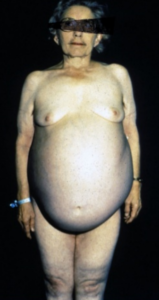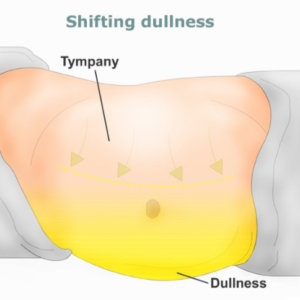
Belly fat may grow so quickly and stick out so much that you fear it’s actually ascites from ovarian cancer, but there are ways to tell the difference.
“The diagnosis of ovarian cancer is extremely difficult and symptoms can remain hidden for months or years because they tend to be vague,” begins Mylaine Riobe, MD, founder of Riobe Institute of Integrative Medicine. Dr. Riobe, board certified in OB/GYN and integrative medicine, is the author of “The Answer to Cancer.”
Dr. Riobe continues, “Because the ovaries are attached to the wall of the abdomen by a ligament and otherwise are free-floating in the abdomen, masses can grow to enormous sizes before being detected on examination.
“It’s important to have a low threshold to evaluate vague symptoms such as onset of persistent bloating [which could be caused by ascites], increase in the girth of the abdomen [again, ascites], pelvic pain, abnormal vaginal bleeding, nausea and malaise.
“Ascites is a late finding in ovarian cancer and is fluid in the pelvis and abdomen.”
There are ways that doctors can distinguish between ascites from ovarian cancer and abdominal distension from belly fat.
However, while you wait for your doctor appointment, there are things you can check for that would point far more to belly fat than ascites.
But keep in mind that you may have BOTH increasing belly fat and ascites.
Ascites will make the abdomen get bigger and increase in circumference without a proportional increase in fat elsewhere.

Massive ascites from ovarian cancer, which had been progressing for six months without treatment. Note absence of “rolls of fat” despite belly size.

Same patient. During that time this 70-year-old patient had weight LOSS. Note the dramatic disparity between size of abdomen and size of limbs. Courtesy: Tom Baker Cancer Centre, Calgary, Canada
However, the phenomenon of an increasing abdominal girth in the absence of increasing size elsewhere in the body occurs to many people who do not have ascites.
We’ve all seen people with scrawny or non-overweight arms and legs who have ever-growing bellies.
This phenomenon is particularly prevalent in people over 50 who have never strength trained and who lead sedentary lives.
Belly Fat and Ascites: Unique Features of Each
• If enough increasing amount of fat is getting stored in your abdomen, you should also be able to see an increasing amount of fat at your waist and a little behind it, towards the back — and if there’s enough of it, you’ll be able to grab it like bread dough.
• Nobody gains only a lot of fat in the belly while their sides and back remain lean.
Look at the sides and backs of women with fatty potbellies. There are clear signs of excess fat deposits.
• As the belly grows from fat storage, you will be able to pinch an increasing amount of blubber at your sides and going towards the back.
• A blubbery stomach with no ascites will have at least one “roll.” If there’s even only one, you will see this when viewing the profile or three-quarter view — as in the image below.

Shutterstock/L Julia
The stomach will cave in at the middle, then puff back out. In an abdomen free of much excess fat but full with excess fluid, this cave-in area will be absent — as in the previous image.
• If you eliminate junk food and practice portion control, and increase your exercise enough to create a marked daily caloric deficit, you’ll lose several pounds of fat quickly, causing a visible reduction in your abdominal girth when viewed profile.
• If you have ascites, you cannot diet or exercise it down.
• A visible gain in belly size over just one week does not necessarily mean ascites if you’ve been eating way more than usual.
And if you’re as hungry as you’ve always been, and especially hungrier than ever, chances are pretty high that you don’t have excess abdominal fluid — because this classically causes appetite LOSS.
• In yo-yo dieters in which the cycle of weight gain and loss repeats itself, the appearance of the abdomen will also fluctuate.
However, ascites from ovarian cancer will not come and go.
• Often, ascites is accompanied by a feeling of persistent bloating.
• Ascites may also cause difficulty breathing because the excess fluid interferes with diaphragm function.

Patient is 25 with ovarian cancer ascites. Note exceptionally smooth and taut appearance of skin; no “blubbery” features or rolls of fat. International Journal of Case Reports and Images.
• In ovarian cancer, a thin woman’s stomach may just keep expanding while the rest of her remains thin.
Her belly won’t have that classic blubbery look of overweight.
Finally, if you’re lying on your side and notice a shift of your belly downward, this is a sign of ascites…as depicted below. The yellow area would be the ascites.

Mild Ascites vs. Mild Abdominal Fat
“It’s not really possible to distinguish mild ascites from belly fat,” says Dr. Riobe, referring to the layperson staring at their abdomen in the mirror.
“A CT scan or ultrasound would quickly distinguish between the two.
“I would not recommend that anyone try to distinguish the two without medical assistance, as time is of the essence in the case of ovarian cancer.
“The sooner it’s diagnosed, the better the outcome.”
How Doctors Test for Ascites from Ovarian Cancer
“When the abdomen is ‘percussed’ by the physician (vaguely beaten like a drum with one finger over the other), the abdomen should sound hollow,” says Dr. Riobe.
“If it doesn’t then that may be an indication of a mass or fluid. You can also tilt the patient and percuss to see if there is fluid in the abdomen.
“This is not a precise examination by any means but can give some information during a workup.
“A pelvic exam, radiological study such as CT or ultrasound and blood work called CA-125 can assist in the diagnosis.
“A definitive diagnosis is obtained by removal of a visible mass and examination by a pathologist to determine the tissue type and diagnosis.”
The presence of new-onset symptoms such as gas, constipation, feeling full after small meals, suppressed appetite, fatigue and pelvic or lower abdominal cramps – plus an expanding abdomen despite no increase in food intake – and especially a reduction in food intake – is highly suspect for ovarian cancer.
Conditions other than cancer can cause these symptoms, though if ascites is confirmed, you have a serious condition nevertheless – even if it’s not ovarian cancer.
This is because no benign condition causes ascites. In fact, most cases of ascites are caused by liver problems.


























